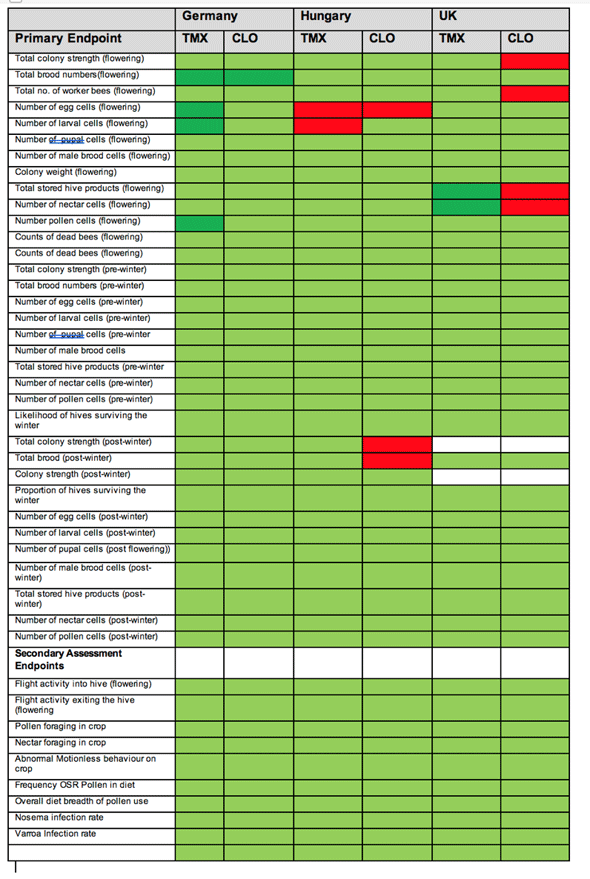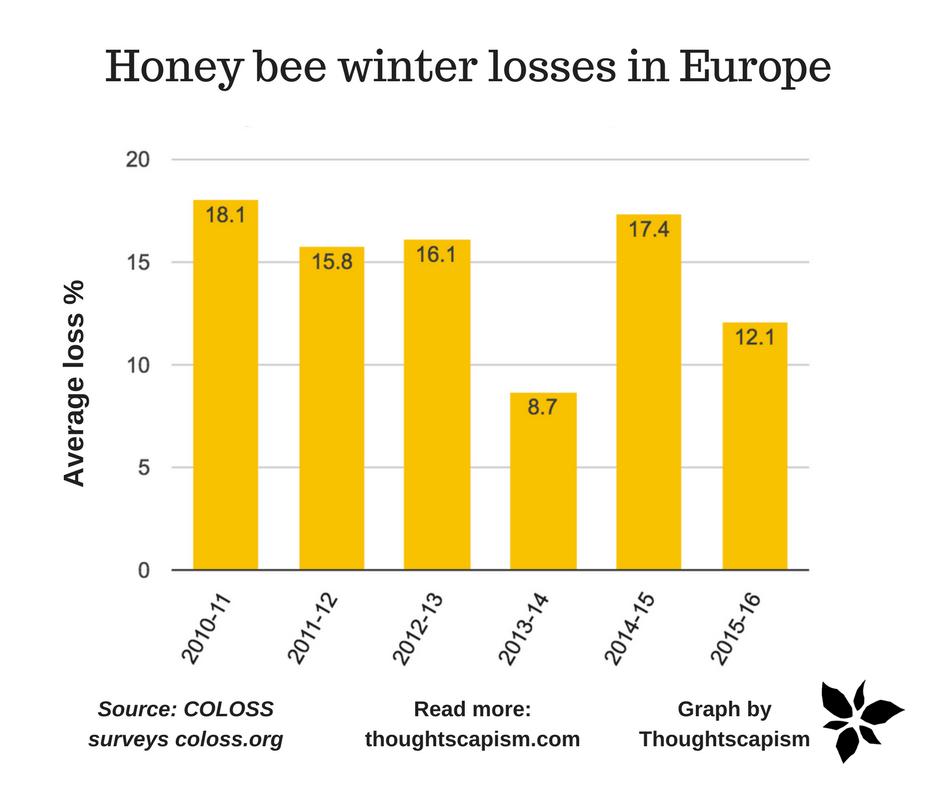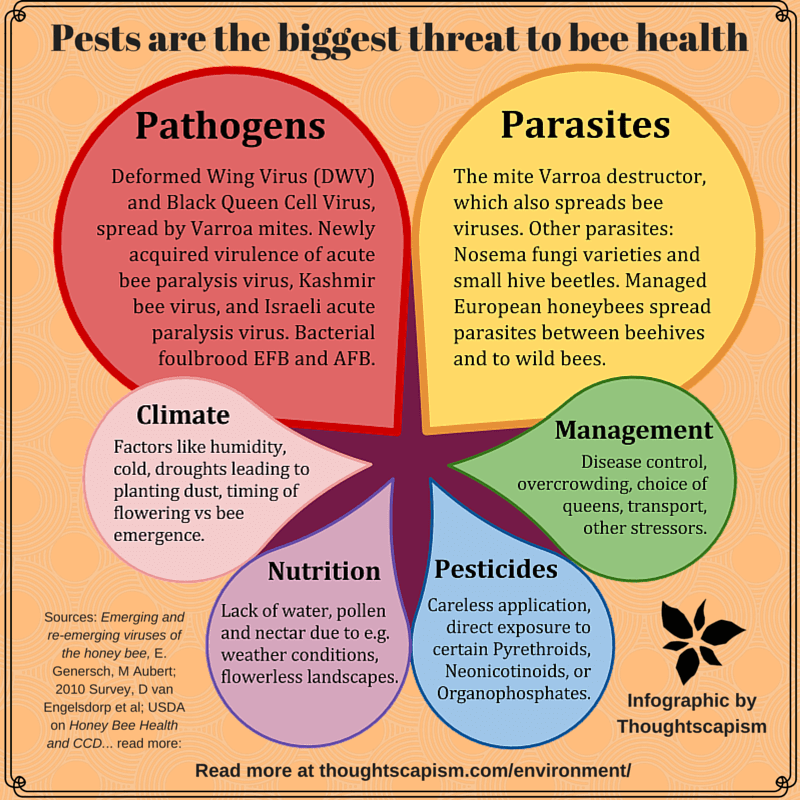Two new bee papers were published just a few days ago. Below I will take a closer look at one of them, the larger European study, partly funded by pesticide companies but performed by an independent research lab, and it was aimed to be a more comprehensive test of neonicotinoids. The other one was a five-month field study in Canada, completed with a year-long lab study where they observed some negative health effects under field-similar but constant exposure conditions, especially when combined with a fungicide.
The European study went on for two years in three countries, spanning over 33 sites. A whopping 88 variables were measured (different health measures, different bees, etc). but only eight of them came out with a statistically significant difference. Three variables actually showed a significant beneficial correlation between neonicotinoid treatments and bee health, whereas five correlated with more harmful results. However, 18 results had to be dismissed altogether because the Varroa mite killed off many UK hives. But the study did not choose to track disease rates as variables.
This Arstechnica piece by a long-time biology researcher gives a succinct coverage of this science news (which are reflected in all kinds of headlines in the media already): Study paints a confusing picture of how insecticides are affecting bees:
a team of independent researchers purportedly tied neonicotinoids to bee colony health. But a quick look at the underlying data shows that the situation is far more complex. And a second paper, with more robust results, supports the idea that these insecticides are merely one of a number of factors contributing to bees’ problems
The researchers themselves indeed put their results in a rather peculiar way. They say their study supports the harmful effects of neonicotinoids, but in ‘a country-specific way’. As they found statistically significant beneficial effects mainly in Germany (though one was in the UK), they argue that this may be explained by other factors, because the bees were found to be in generally better health in Germany. For UK and Hungary, however, where bee pests were more of a problem, and the sources of nutrition were more limited, they say the five significant findings can be interpreted as an interaction-effect of neonicotinoids. They write:
The country-specific responses of honey bees and bumble bees strongly suggest that the effects of neonicotinoids are a product of interacting factors (20–23). This study has identified between-country differences in the use of oilseed rape crop as a forage resource for bees (affecting exposure to crop residues) and incidence of disease within hives. Both factors were higher for Hungarian and U.K. honey bees (tables S10 and S11).
The study presents the presence of neonicotinoid treatment significantly correlating with a negative effect on worker numbers (UK), storage cell number (UK, clothiadinin), and one species of wild bee drone numbers (UK), as well as egg cells (Hungary) and worker numbers (Hungary).
Whereas they also find that neonicotinoid treatments significantly correlate with egg cells (Germany), drone numbers (Germany) and storage cells (UK, thiametoxam) but in a positive direction.
So in UK, storage cell numbers were diminished by clothiadinin but boosted by thiametoxam…? Sounds peculiar. At what point would a beneficial correlation also suggest a causative relationship? When measuring correlations, it is good to be watchful for factors that may either have no real connection, or have a more complicated relationship than a simple cause and effect – as an example, both may follow from another variable so they correlate without a causal relationship with regard to each other.
What seems problematic in the logic of the authors, is that if the three observed beneficial effects can be considered the result of factors other than neonicotinoids, then the same could be said about the five cases where they detected harmful effects. If you consider that significant effects in either direction represent a very minor portion of the results, it seems like an awful lot of weight is being put on these five out of 88 findings.
A look at the raw data
The small number of findings becomes particularly clear when we look at the summary of all the measured endpoints – raw data which for some reason was not included in the supplemental material of the study, but was released from the study’s partial funder, Syngenta, instead. The inclusion of the total data table in this piece in Slate is quite illuminating: Do Neonics Hurt Bees? Researchers and the Media Say Yes. The Data Do Not. Light green cells show no significant difference between beehives near treated fields and controls, red cells point to a significant difference for the worse, and dark green shows the beneficial correlations (my apologies to the red-green colour-blind, I don’t have the original so can’t change the colors easily).

Out of these 258 data points, only 9 were negative and 7 were positive, 3.5 and 2.7 % of cases respectively. Four colonies gave no data (I assume these cells are for the colonies where controls and treatment groups were wiped out by Varroa mites and diseases). Almost all negative data points came from clothianidin (7 of 9), whereas thiametoxam had 6 out of the 7 positive findings, and two negative findings. If these results truly are to be taken as suggestive of causation, should we take them to mean thiametoxam treatment is beneficial for bees? Somehow I wouldn’t be ready to easily assign such predictive power to these results one way or another, when so many data points found no difference at all.
The inconsistency is also problematic if you consider statistics of bee health and winter losses in general, which are the product of many factors, several not tracked by this study, and that show great variability. The scientists themselves hint at as much in their supplemental materials:
Other potential covariates showed strong systematic variation with either country or seed treatment and as such could not be directly tested within this framework without violated underlying model assumptions (e.g. the proportion of oilseed rape making up the diet of pollen (Table S10), disease (Table S11) and starting colony size (Table S2)).
Bee losses are known to vary a great deal across countries and years in Europe. From the COLOSS bee surveillance project on 2015 and 2016 numbers:
These loss rates vary considerably between countries. In this year’s survey the highest losses were found in Ireland and Northern Ireland, followed by Wales and Spain. The pattern of loss rates differs from last year, when higher mortality and loss rates were found in central Europe and countries to the east. This year the higher loss rates tend to be in the west and northern countries, although Spain had high rates of loss in both years.
The losses have generally been lower in Europe than in the US in the last decade or so, and a recent Pan-European epidemiological study found that honey bee colony survival depended on beekeeper education and disease control – it was first and foremost hobby beekeepers who had trouble with epidemics, whereas professional beekeepers in Europe had very little problems with diseases and Varroa (more on that in my piece: Treatment-free beekeepers give Varroa mite free rein). It is unfortunate, in this context, that the study lost entire colonies to Varroa, and it raises questions about the presence of diseases in the study colonies in general.

As a side note, the partial ban of neonicotinoids by the European Commission on three chemicals: clothianidin, imidacloprid and thiamethoxam, came in effect December 2013 and as such, would have been unlikely to have had even a potential effect on the statistics above before winter 2014-2015. The scope of the suspension only applied to “the treatment of seeds or soils for crops that are attractive to bees (except greenhouse crops and winter cereals) and the spraying of crops that attract the pollinators (except post-flowering and greenhouse crops).”
More questions – what is the role of fungicides?
Another factor with regard to the European study, pointed out by a piece by pollinator researcher David Pattemore, is an inconsistency in the fungicide applied together with the neonicotinoids at different sites. From More evidence on the effects of neonicotinoids on honey bees…maybe?:
But all three treatments (the control and the two different neonicotinoid treatments), had different fungicide treatments applied with them, violating the basic scientific rule to control all variables apart from the one you are interested in, or at least account for these other variables. This study, unfortunately, has confounded neonicotinoid treatment with fungicide treatment, so it is not really possible to draw many conclusions on neonicotinoids alone. So my personal opinion is that the effect on honey bees in this study is ambiguous at best.
He also puts these studies in the context of earlier research:
So in terms of the number of studies evaluating the hypothesis that real-world use of neonicotinoids have colony-level effects on honey bees, the score in my calculation now stands at 2 for, 4 against. This is how science proceeds: we are likely to continue to see scientific tussles back and forth while we narrow in on the actual suite of factors that affect honey bee health.
While many headlines have hurried to report on these studies as a confirmation of neonicotinoids’ role in bee health, several news outlets have also handled the topic with admirable nuance. Consider this Washington Post headline: Controversial pesticides may threaten queen bees. Alternatives could be worse. Insecticides are indeed likely to have some negative effects on bees , even though it is hard to pinpoint the realistic degree of the effect. Nevertheless, what is clear is that we can’t properly address bee problems if we ignore the larger issues of pests, disease, and habitat loss. From the Washington Post piece:
The differences between bees in treated or untreated fields were largely insignificant, and many of the bees in both groups died before they could be counted.
…
Christopher Cutler, who studies insect toxicology at Nova Scotia’s Dalhousie University, echoed Carreck’s concerns, pointing out that “when many different analyses are conducted” (42 in this case), “a small number of statistically significant effects are bound to emerge by chance.
…
An approach popular with activists would be to ban neonicotinoids altogether, but many experts worry this would cause farmers to turn to older and potentially more harmful methods of pest control. “Things are better for honey bees since neonics replaced more harmful insecticides,” said beekeeper and science blogger Randy Oliver.

In other words: if you care about bees, look past neonicotinoids. No, we should not ignore their effects, we should welcome more solid research, and we should definitely try to find optimal ways of using them with minimal harm to non-target insects, while maximizing their effect in helping keep down resource use like land, fuel, and other inputs, that goes into growing crops.
The European partial ban, based on the information so far, might have even had some net negative effects for the environment: some farmers are simply narrowing their rotation to crops that are not as sensitive to the relevant pests. From Foodinsight:
Yields are down and the area sown is falling as some farmers are switching to other crops because they do not want to take the risk. This means rapeseed is being dropped from crop rotations which has a negative environmental impact,” Max Schulman, of Copa & Cocega said.
It is great to get more research about the effects of neonicotinoids. But what about the effects of other pesticides? Before we jump into a ban, we should compare the situation to the alternatives. What realistic solutions do farmers have? How would those alternatives affect the health of bees, other non-target insects, carbon emissions, soil health, or any number of other important factors? In the words of the agricultural researcher Andrew Kniss, Everything in Agriculture is a Trade-Off.
A version of this article appeared at the blog Thoughtscapism as “New Study Finds Neonicotinoids May Have Harmful, Beneficial, or No Effects on Bees” and has been republished here with permission from the author and the original publisher.
Iida Ruishalme, Finnish by birth and now a Swedish resident, is a cell biologist and science communicator, and author of the Thoughtscapism blog. You can follow her on Twitter at @Thoughtscapism.































